Impact of HLA evolutionary divergence and donor-recipient molecular mismatches on antibody-mediated rejection of kidney allografts
- PMID: 40592858
- PMCID: PMC12219110
- DOI: 10.1038/s41467-025-60485-y
Impact of HLA evolutionary divergence and donor-recipient molecular mismatches on antibody-mediated rejection of kidney allografts
Abstract
Several in-silico methods emerge to assess HLA immunogenicity and stratify immunological risk, including HLA molecular mismatches and HLA evolutionary divergence (HED). However, their added value in risk-stratifying antibody-mediated rejection (AMR) remains uncertain. We include 5159 kidney transplant recipients from four centers. Thirty-three clinical and immunological parameters are assessed, including HLA eplet mismatches, PIRCHE-II scores, and HED. Their associations with AMR are evaluated using Cox models. AMR occurrs in 1024 patients (19.9%). Immunological determinants of AMR include anti-HLA DSA (MFI:500-1400, HR:1.87; MFI > 1400, HR:3.84, p < 0.001) and HLA Class II eplet mismatches (HR:1.02, p < 0.001). HLA-DQB1-derived (HR:1.01, p = 0.005) and HLA-DRB1-derived PIRCHE-II scores (HR:1.01, p = 0.001) are also associated with AMR, while HED is not. These findings remain consistent across centers and subpopulations, including non-sensitized patients (n = 4137). Our findings show that Class II molecular mismatches are independently associated with AMR. HED shows no association, suggesting limited utility for immune-risk stratification at a population level. Clinicaltrials.gov: NCT06436586.
© 2025. The Author(s).
Conflict of interest statement
Competing interests: The authors declare no competing interests.
Figures


Similar articles
-
Donor HLA Class I Evolutionary Divergence and Late Allograft Rejection After Liver Transplantation in Children: An Emulated Target Trial.HLA. 2025 Jul;106(1):e70320. doi: 10.1111/tan.70320. HLA. 2025. PMID: 40667760
-
Assessing the Predictive Power of PIRCHE-II Scores for the Development of De Novo Donor-Specific Antibodies After Simultaneous Pancreas-Kidney Transplantation.Transpl Int. 2024 Dec 18;37:13720. doi: 10.3389/ti.2024.13720. eCollection 2024. Transpl Int. 2024. PMID: 39744043 Free PMC article.
-
Donor-Specific Antibodies Targeting a Repeated Eplet Mismatch and Outcome After Kidney Retransplantation.Transpl Int. 2024 Nov 29;37:13639. doi: 10.3389/ti.2024.13639. eCollection 2024. Transpl Int. 2024. PMID: 39679067 Free PMC article.
-
Sex and gender as predictors for allograft and patient-relevant outcomes after kidney transplantation.Cochrane Database Syst Rev. 2024 Dec 19;12(12):CD014966. doi: 10.1002/14651858.CD014966.pub2. Cochrane Database Syst Rev. 2024. PMID: 39698949
-
Perspective for Donor-Derived Cell-Free DNA in Antibody-Mediated Rejection After Kidney Transplantation: Defining Context of Use and Clinical Implications.Transpl Int. 2024 Aug 12;37:13239. doi: 10.3389/ti.2024.13239. eCollection 2024. Transpl Int. 2024. PMID: 39188271 Free PMC article. Review.
References
-
- Lim, W. H. et al. Human leukocyte antigen mismatches associated with increased risk of rejection, graft failure, and death independent of initial immunosuppression in renal transplant recipients. Clin. Transplant.26, E428–E437 (2012). - PubMed
-
- Sellarés, J. et al. Understanding the causes of kidney transplant failure: the dominant role of antibody-mediated rejection and nonadherence. Am. J. Transplant.12, 388–399 (2012). - PubMed
-
- Lohéac, C., Aubert, O., Loupy, A. & Legendre, C. [Identifying the specific causes of kidney allograft loss: a population-based study]. Nephrol. Ther.14(Suppl 1), S39–S50 (2018). - PubMed
Publication types
MeSH terms
Substances
Associated data
LinkOut - more resources
Full Text Sources
Medical
Research Materials

